The path to AI maturity
Introduction
In late 2021, LXT commissioned a survey of 200 senior executives (two-thirds C-Suite) with artificial intelligence (AI) experience at mid-to-large US organizations. The goal of the research was to understand the current status of AI maturity in organizations overall, and the unique characteristics of organizations based on their AI maturity phase. The results of this study reveal the investment levels and business drivers behind AI initiatives at all phases – and the associated benefits of AI – which can help shape the business case for increased investment in the technology to fuel business growth.
This study is based on Gartner's AI Maturity Model which characterizes an organization's journey with AI into 5 levels:
Gartner’s AI maturity model levels
- Level 1: Awareness – An early interest in and conversations around AI strategy
- Level 2: Active – Initial experimentation and pilot projects with AI
- Level 3: Operational – AI used in at least one workflow
- Level 4: Systemic – AI is present in the majority of workflows/operations, inspiring new, digital business models
- Level 5: Transformational – AI is inherent in the DNA of the business
The findings in this study provide guidance for organizations whose goal it is to reach the Transformational level and reveal the characteristics of the companies who have succeeded in reaching this phase.
This report also examines AI trends by industry, including an analysis of AI maturity for five verticals. The research investigates how the drivers behind AI strategies differ for these industries.
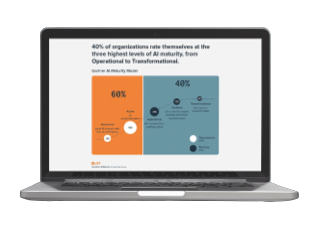
Want to read this report later?
Key findings
AI investment
- More than half of organizations surveyed (56%) are spending between $1 million and $50 million on AI annually, and 15% are spending $51 million or more.
- Over a third of high revenue companies are spending between $51 million and $100 million on AI annually.
- AI strategies are primarily driven by innovation and growth needs, where AI enables businesses to scale and innovate faster, and to secure competitive advantage.
- Efficiency and productivity gains are seen as the most dominant problems that AI can solve across industries. Improved analytics and business expansion are also high priorities.
AI and maturity levels
- 40% of organizations rate themselves within the three highest levels of AI maturity according to Gartner’s AI Maturity Model: Operational, Systemic, and Transformational.
- Companies in the Systemic and Transformational levels of the AI maturity model are using AI to scale and drive competitive advantage and product innovation. They are also budgeting higher amounts overall for AI programs, and are using both supervised and semi-supervised machine learning methods.
- AI investment and AI maturity correlate, with a quarter of AI maturing organizations spending $51 million or more on AI, compared to just 8% of experimenters (those organizations in the awareness and experimental stages of AI adoption).
- Regarding the drivers behind AI strategies, businesses at the Transformational end of the scale have already experienced the benefits of better risk management and delivering on customer needs. Now, they are looking to scale up and accelerate product innovation. AI Experimenters are focused on driving innovation and managing large volumes of data.
- AI Maturing organizations rely more on semi- and fully-supervised machine learning and AI nascent organizations report a greater use of unsupervised machine learning.
- Maturing organizations view quality training data as an essential contributor to AI success.
- When asked about the benefits experienced as a result of high-quality training data for AI, Experimenters see efficiency and agility gains, while Maturing organizations report accelerated time to market and improved competitive advantage.
- Two-thirds of all respondents expect their need for training data to increase over the next five years, and AI Maturing organizations indicate the highest need to increase their training data budgets over this timeframe.
AI trends by industry
- The financial services industry is leading the way, with 43% of organizations having reached Systemic or Transformational levels of AI maturity.
- The tech industry follows the financial services industry, with 22% of organizations having reached the highest levels of AI maturity.
- Respondents state that efficiency and productivity gains are the most common goals of AI strategies for their industries as a whole, except for financial services companies, which say that improved analytics is the main goal.
- The tech, retail, manufacturing/automotive and professional services industries are deploying AI to innovate and advance product development, while financial services companies are driven by competitive advantage and risk management.
- Text data is the leading type used across all industries; future data types include audio, user behavior and video.

01 AI investment
AI investment is strong across mid-to-large US organizations
The potential of AI has yet to reach its peak. AI continues to boom as both a trend and emerging technology, with many organizations investing heavily in AI innovation. The strategic importance of AI is growing rapidly too, as businesses start to see the benefits of their investments.
Seven in ten organizations are spending $1M or more of their budget on AI
Our research found that over half of organizations (56%) are spending between $1 million and $50 million on AI annually, and 15% are spending $51 million or more.
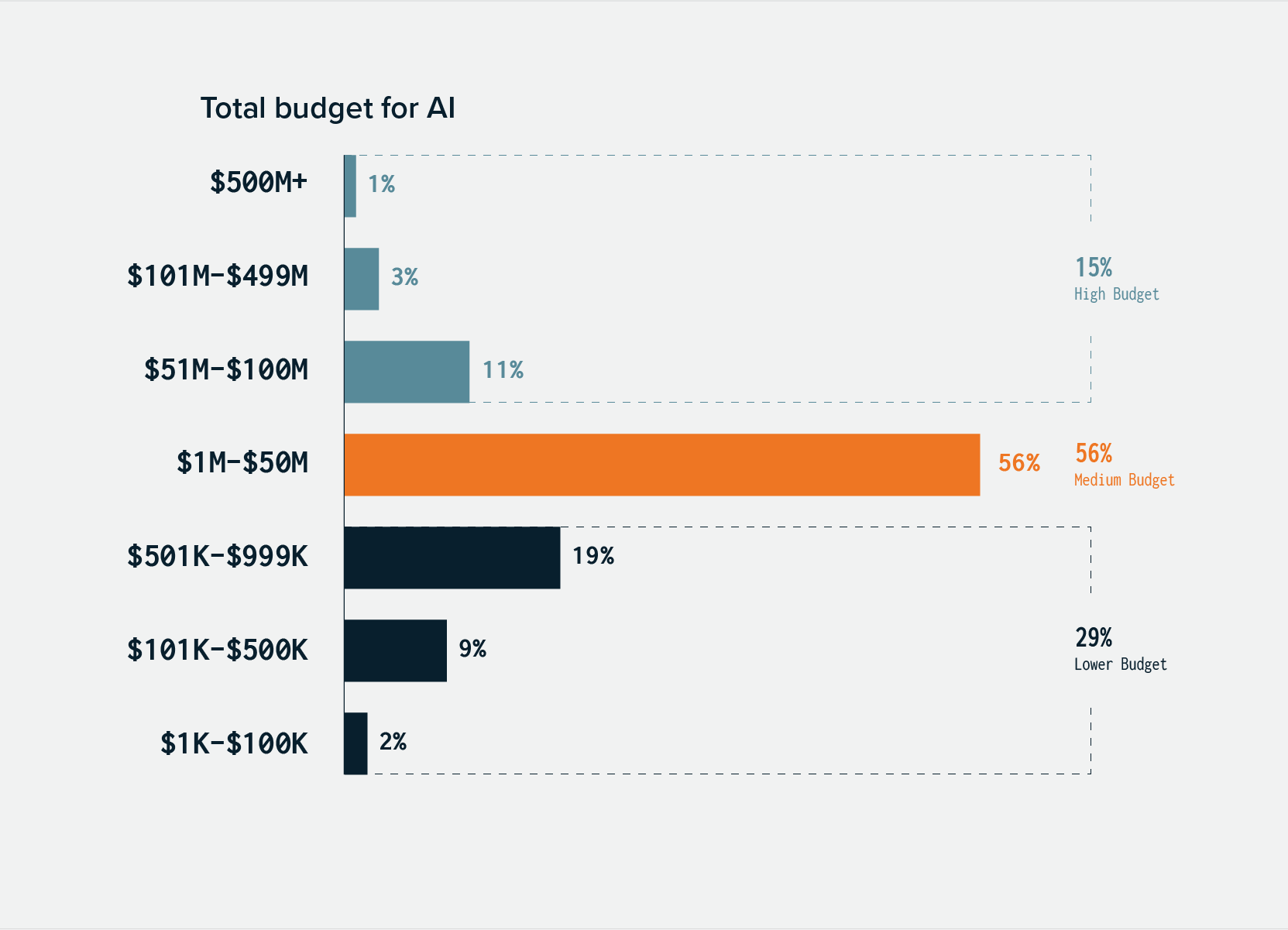
AI budgets correlate with an organization’s revenue
When it comes to companies grossing $100 million to $1 billion a year, AI investments are proportionally steep. The annual budgeted spend on AI for these businesses falls between $1 million and $50 million. And for that upper level of businesses earning $1 billion in revenue, 37% of them are spending $51 million to $100 million on AI.
LXT State of Training Data in AI.
Survey Q10: In which range approximately is your organization’s total budget for AI?
Survey Q2: Approximately how much is your company’s annual revenue worldwide?
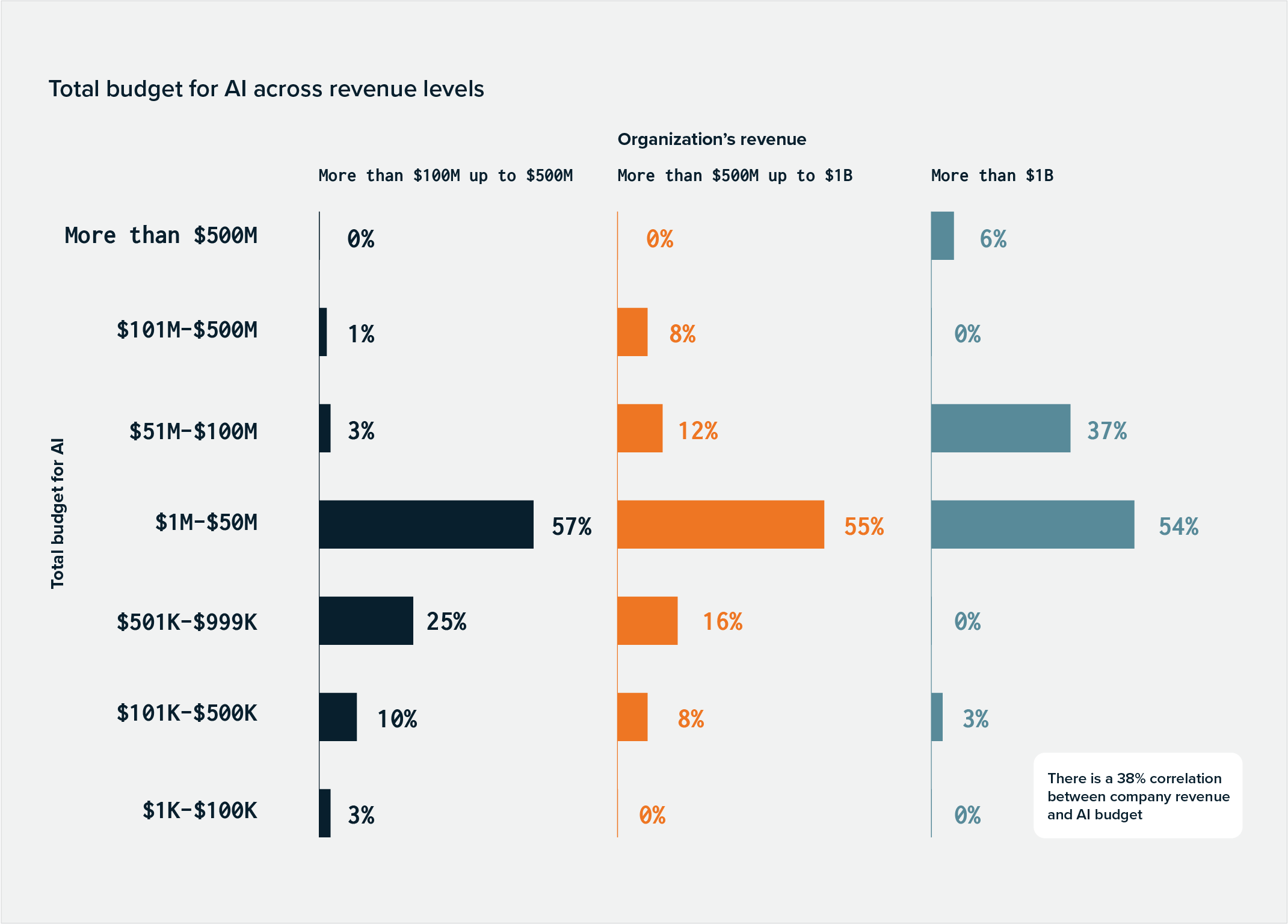
Overall, there’s a good correlation (38%) between an organization’s revenue and its level of AI investment
43% of organizations with over a $1 billion of annual revenue are spending $51 million or more on AI annually. In contrast 95% of organizations with less than half a billion revenue are spending less than $50 million annually on AI.
Innovation and product development are key drivers for AI strategy
Organizations surveyed said there were five primary drivers for investing in AI:
- Innovation and product development
- Ability to scale more quickly
- Competitive advantage
- Risk management
- Handling large volumes of data
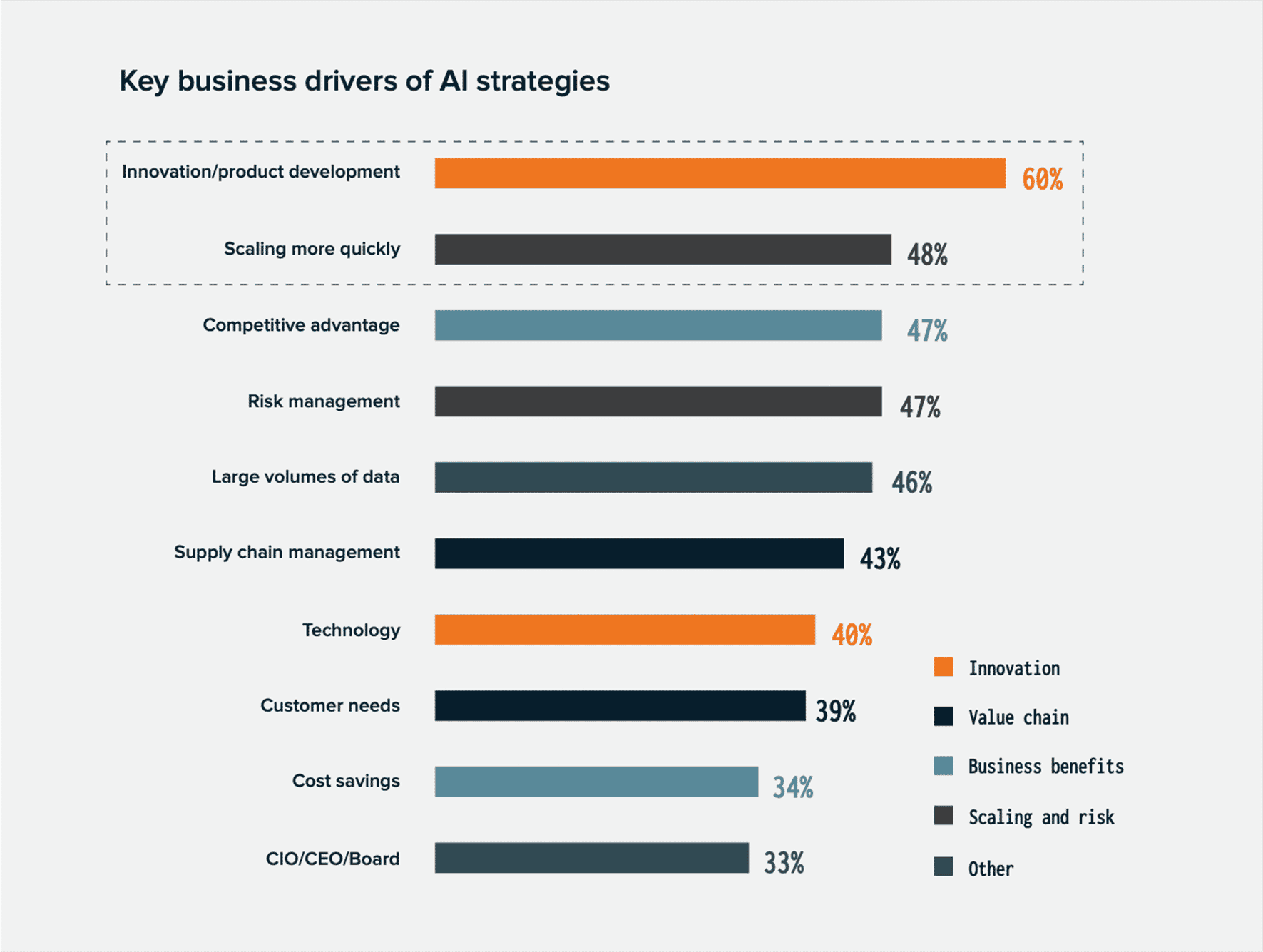
Businesses agree that AI brings efficiency and productivity gains
When asked about the potential impact of AI on their specific industries, 65% of survey respondents state that efficiency and productivity gains are the most dominant problems that AI can solve. This is followed by improved analytics (50%) and business model expansion (48%). Customer retention ranked lowest at 33%. Respondents were able to select as many options as were applicable to their organization from a list of choices.
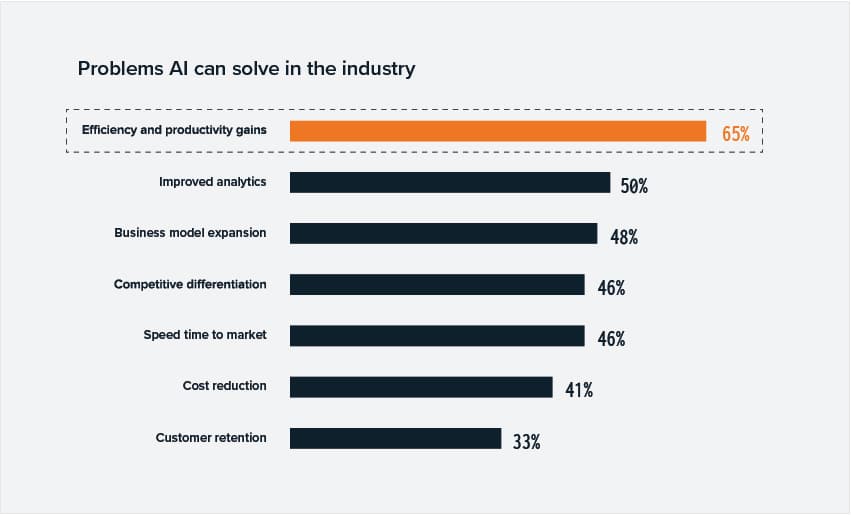
02 AI trends by maturity level
AI implementations are getting closer to maturity
Gartner’s AI Maturity Model was used to gain objective insight into how organizations characterize the sophistication of their AI implementations. The organizations surveyed were asked to select the level of AI maturity for their organization from one of the five Gartner AI Maturity model levels (refer to introduction for AI maturity levels).
Four in ten of organizations have reached high levels of AI maturity
According to the survey results, over 40% of organizations have reached AI maturity or are maturing. These businesses have moved from awareness of and experimentation with AI to succeeding in achieving ROI from AI implementations in production. While there has been significant progress made in the adoption of AI across all industries and a growing number of companies are starting to see ROI from their deployments, there is still a way to go before organizations have realized its full potential.
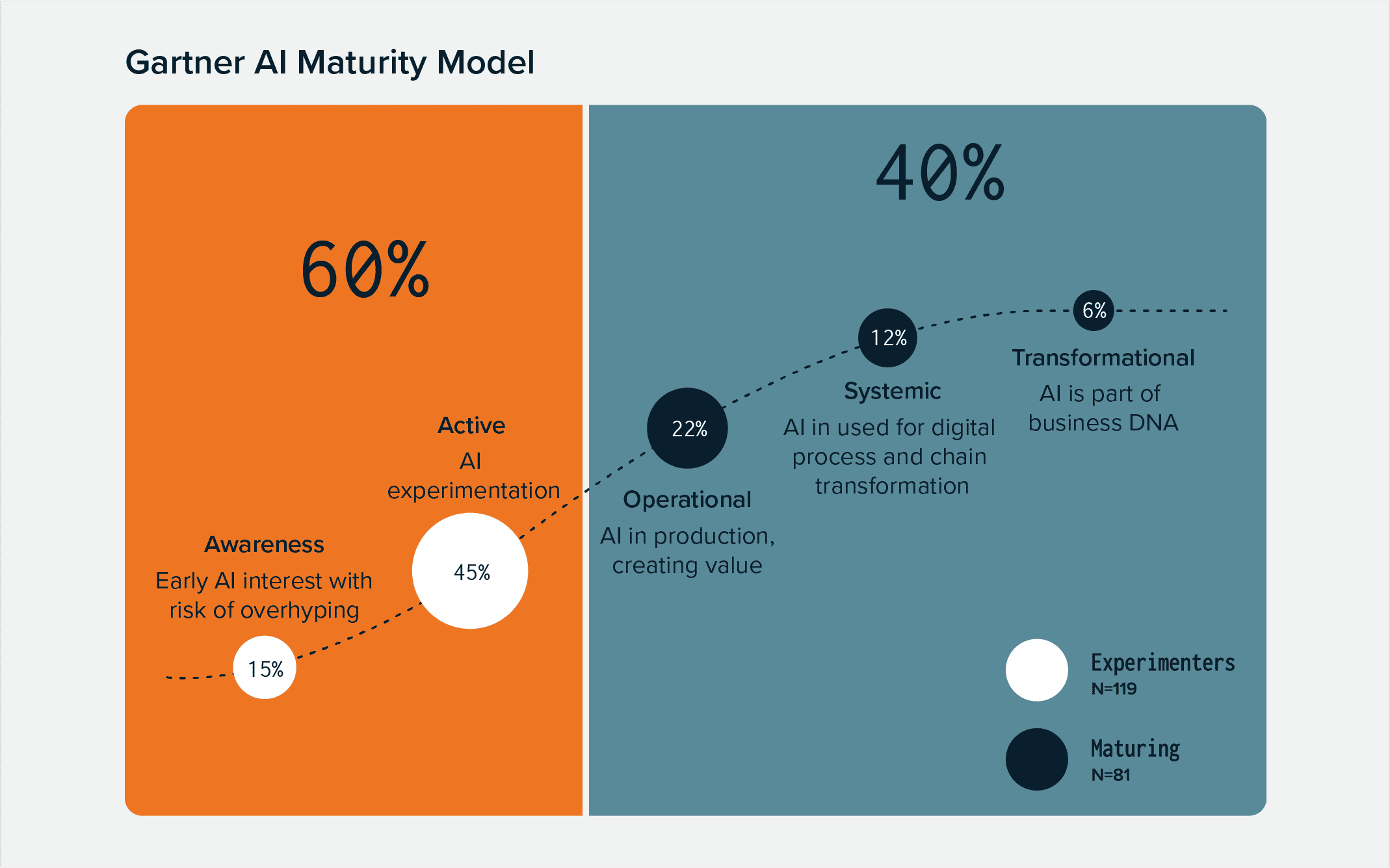
In the remainder of this report, companies in the Awareness and Active stages of AI maturity will be referred to as “Experimenters,” whereas companies in the Operational, Systemic and Transformational stages will be referred to as “Maturing.”
Not all businesses are seeing transformational change — yet
Despite increasing investments and growing AI maturity, only 6% of businesses have reached transformational levels of AI maturity. Transformational change means full penetration of AI systems within the enterprise. In this phase, nearly every internal and external process and interaction is touched by AI.
Gartner’s research into the success rate of AI projects shows that only 53% of projects succeed in moving from the prototype to production1. This demonstrates the difficulty
in scaling AI projects and the effort needed to deploy AI that demonstrates tangible ROI. Given this trend, it is encouraging to see the success rate to date. Organizations have demonstrated that they can truly transform their businesses with AI, paving the way for companies across all industries.
Executives surveyed reported differing approaches, investment levels and results based on their companies’ relative AI maturity level
The survey uncovered that, depending on the level of AI maturity as well as the industry that a particular business operates in, there will be variations in the motivations behind its AI investments.
On the whole, maturing organizations spend more on AI
The first difference that’s worth highlighting is related to overall AI investment. As one might expect, Maturing firms are spending more vs. Experimenters. In fact, a quarter of Maturing organizations are spending $51 million a year or more on AI. These are businesses that are beginning to graduate from AI adoption and transitioning into live AI products, experiences, and systems throughout their internal and external workflows.
Survey Q10: In which range approximately is your organization’s total budget for AI?
Survey Q7: Looking at the Gartner AI Maturity Model diagram below, at what level of AI maturity is your organization today?
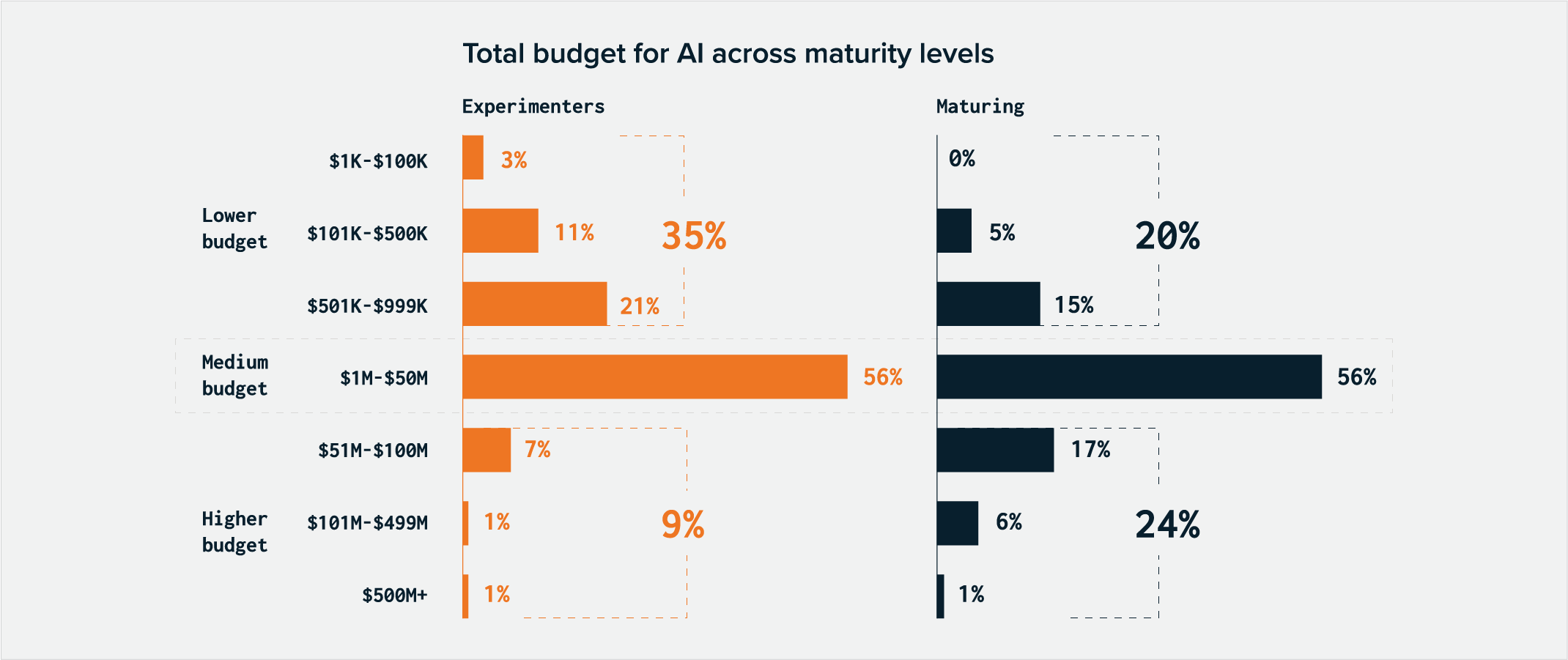
At the same time, out of those businesses that are just beginning to experiment with AI, only 8% are spending $51 million or more. This illustrates a direct relationship between advanced AI maturity/adoption and AI spending. The more businesses have invested in AI, the more resources they put into AI. It’s a strategy that businesses are eager to stick with.
AI Experimenters are largely focused on driving innovation
The study shows that organizations at the very early stages of their AI journey are focused on driving innovation and managing large volumes of data. The perspective of the board and C-Suite also plays a large role as companies identify the use cases for AI within their organizations and move to the experimentation phase.
As companies mature in their use of AI, the results indicate that while innovation continues to be a top driver of the AI strategy, other drivers such as risk management and customer needs become higher priorities. Also, when AI starts demonstrating positive ROI and investments start to pay off, the role of the board and C-Suite in AI strategies becomes less of a driving factor.
Those at the highest levels of AI maturity are now looking to scale up
Businesses that have reached peak levels of AI maturity transition their focus to scaling more quickly. They have successfully moved to production with AI and are now using AI to drive growth.
These businesses are also focused on improving their competitive advantage and accelerating product innovation. Their attention has shifted from building AI systems to capitalizing on the models they’ve built.
Survey Q3: What are the key business drivers of your organization’s AI strategy?
Survey Q7: Looking at the Gartner AI Maturity Model diagram below, at what level of
AI maturity is your organization today?
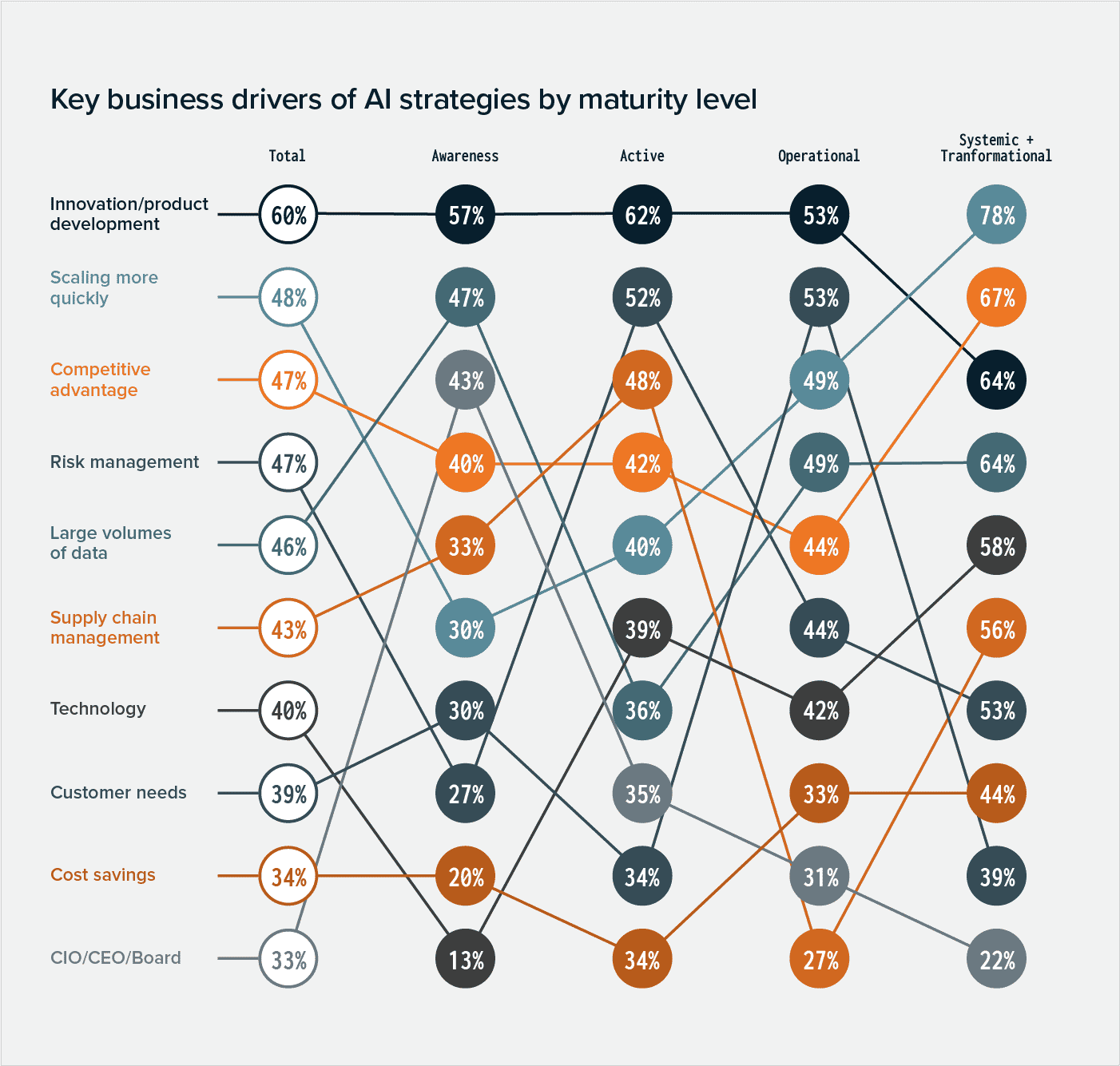
AI Maturing organizations rely more on semi and fully-supervised machine learning in their AI models
A business’s AI maturity also influences the type of machine learning used, with Systemic and Transformational companies utilizing supervised and semi-supervised machine learning techniques equally. That means that their algorithms use a combination of labeled and unlabeled training data. At the other end of the scale, we see a greater use of unsupervised learning which means that their algorithms are trained with unlabeled data. Fifty percent of companies in the Awareness stage use unsupervised machine learning methods, compared with 39% of Systemic and Transformational ones.
As a company moves from the Awareness stage to the Active stage of maturity where it is identifying the right use cases for AI and progressing with experimentation, it relies most heavily on supervised machine learning methods. That results in a need for large volumes of annotated data for new projects to successfully move from pilot to production. Once the organization transitions to the Operational phase where AI is in production and demonstrating ROI, it can increase its use of semi-supervised machine learning, with models in production that are tuned using labeled data. As seen in the chart, the use of semi-supervised learning increases dramatically through the stages of AI maturity, from 37% at the Awareness level to 67% at the Systemic and Transformational levels, as models have been in production longer and have moved from the training to the tuning phases.
Survey Q4: What types of learning do you use for your AI models?
Survey Q7: Looking at the Gartner AI Maturity Model diagram below, at what level of AI maturity is your organization today?

Mature organizations say that quality training data is a key contributor to success
To better understand what is driving success at all phases of maturity, survey respondents were asked to select up to three of the biggest contributing factors. These elements range from the machine learning models and algorithms used, to training data, to quality controls. With regards to data, respondents had the opportunity to select between “well annotated training data” (data that has been appropriately labelled), and “quality training data” (data that is well annotated and is also statistically robust and diverse in order to reduce bias).
The results show that a major differentiator between organizations in the nascent phase of AI and those that have reached the more advanced stages of AI deployment is that companies at the Systemic and Transformational levels of AI maturity cite quality training data as the most important contributor to their AI strategies’ success. Prioritizing data quality earlier in their AI journey could help accelerate companies’ progress towards AI maturity.
For organizations in the earliest phase of AI maturity, the findings show that well-annotated training data is viewed as the highest contributor to success. At this stage the focus is on finding the right use case for the organization and demonstrating that AI can solve a specific problem. However, as companies move through the phases of AI maturity and reach a tipping point where AI is successfully in production, quality training data increases in importance. Once the highest levels of AI maturity are reached, where AI is used in a systemic and transformational way across the organization, the need for accuracy — and therefore higher quality data — becomes greater.
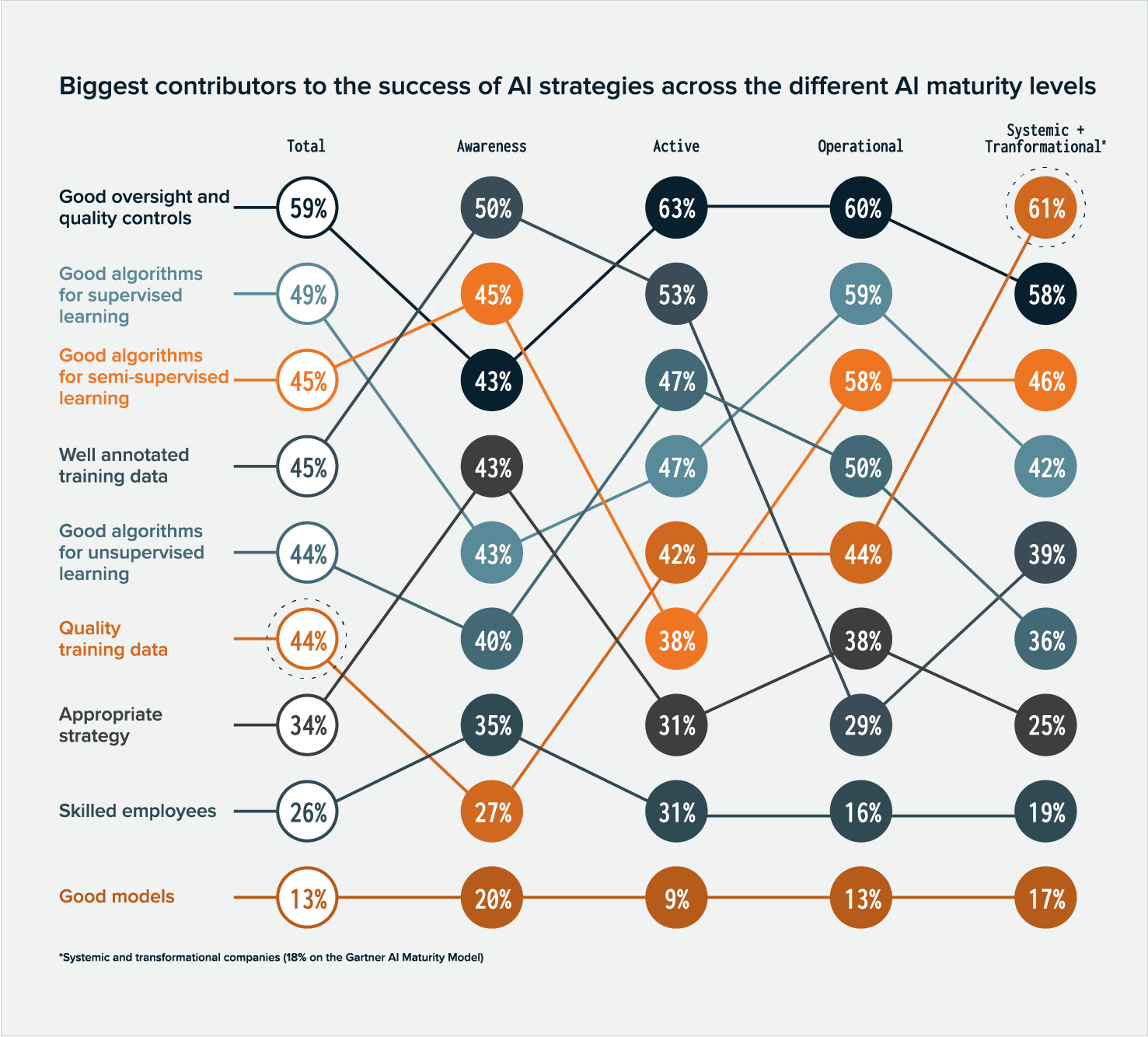
Experimenters see efficiency and agility gains, while Mature organizations seek competitive advantage
While all companies surveyed said they expect to increase their investment in quality training data in the coming years, the benefits motivating this investment differ depending on maturity level. Organizations at the Experimenter stage of AI are seeing improvements in efficiency (45%) and agility (41%), while Maturing businesses unlock benefits such as accelerating product launches (59%) and improved competitiveness (53%). As organizations mature their AI strategies, they can use high-quality training data to not only improve internal processes, but to become more competitive as well.
Survey Q14: Which, if any, of the following benefits has your organization experienced as the result of using high-quality training data for AI?
Survey Q7: Looking at the Gartner AI Maturity Model diagram below, at what level of AI maturity is your organization today?
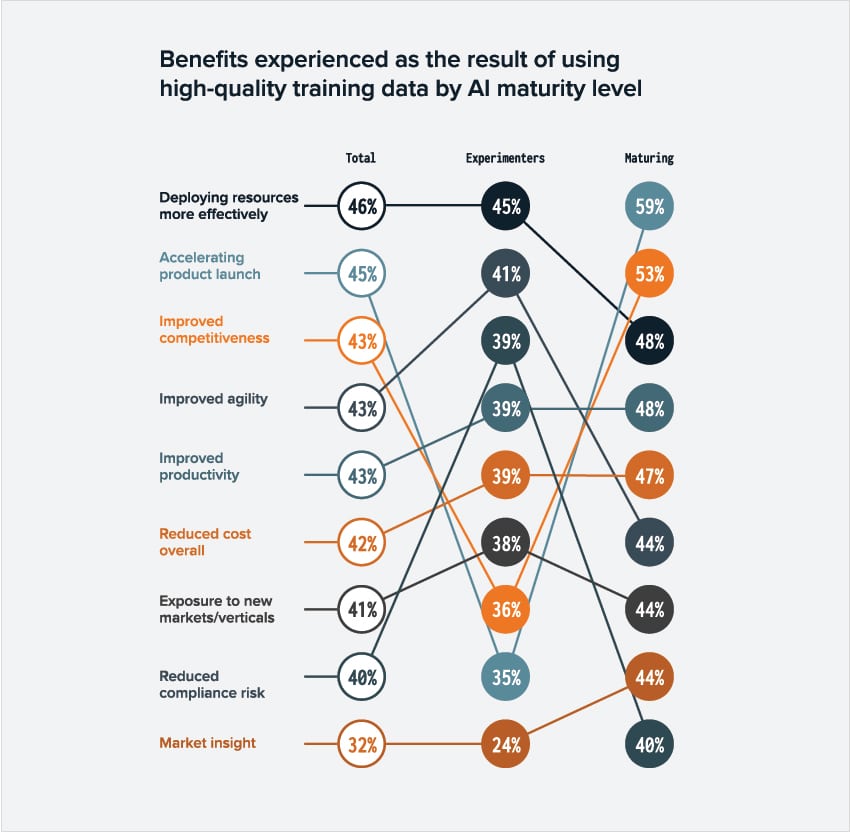
Current investment in AI training data is strong and will increase
The survey findings reveal that organizations across all levels of maturity are dedicating significant percentages of their overall AI budgets to training data. Four in ten companies are allocating 70% or more of their total AI budget to training data. This can include data collection, data processing and data annotation either internally or by
third parties.
On average, businesses are investing 59% of their budget on training data. This suggests that even outside of the businesses with a larger budget, training data still makes up a majority of AI spend across companies.
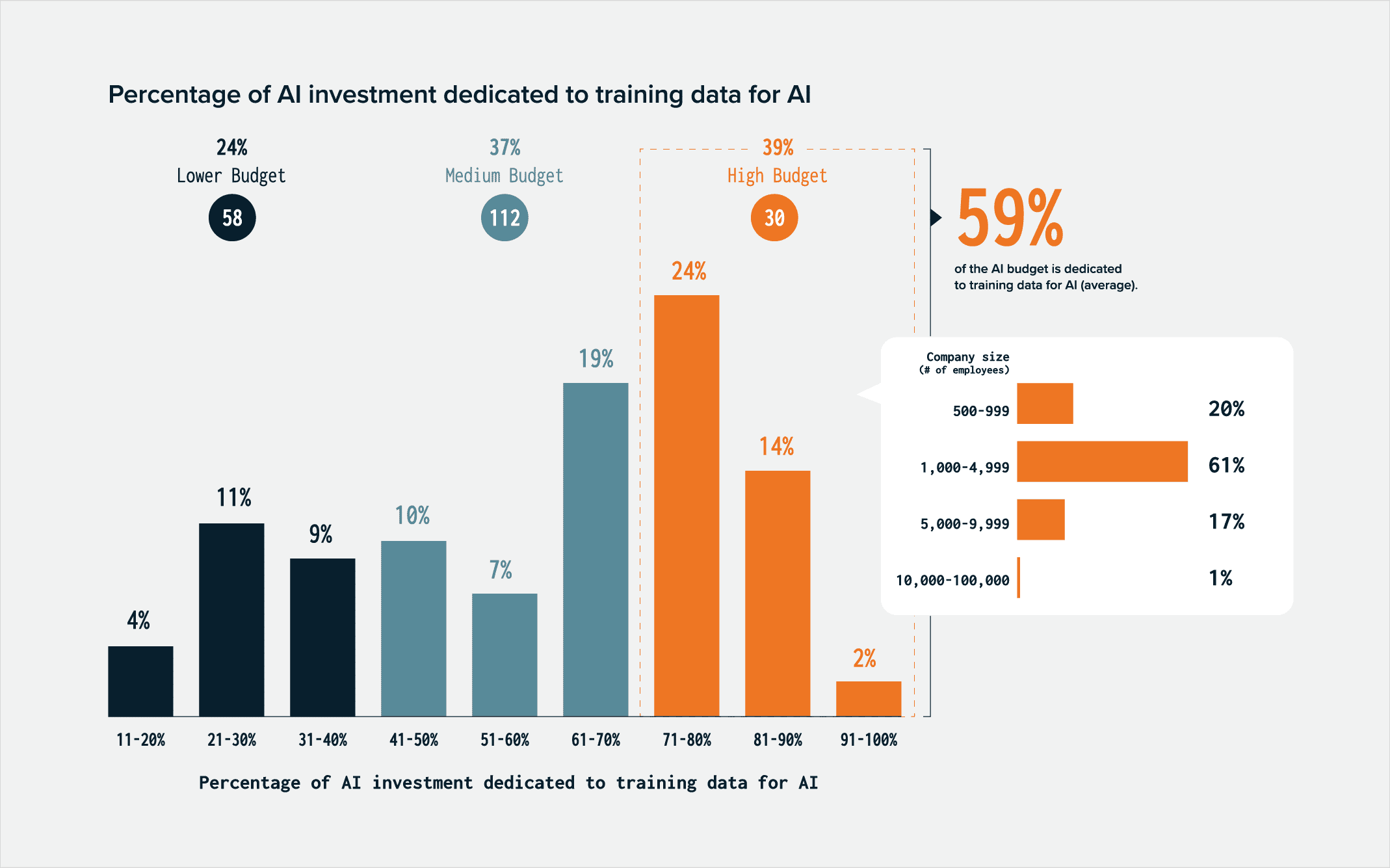
Organizations across industries are accelerating their digital transformation to stay competitive and are using AI to achieve this goal. Coupled with this is expected growth in demand for training data; two-thirds of those surveyed indicated that their need for training data will increase over the next five years.
A deeper look into the results shows that organizations that have reached the highest level of maturity indicate the strongest need to increase their training data volumes over this time period. As companies deploy more AI models across an increasing number of functions and processes, more training data is needed to support periodic model updates.
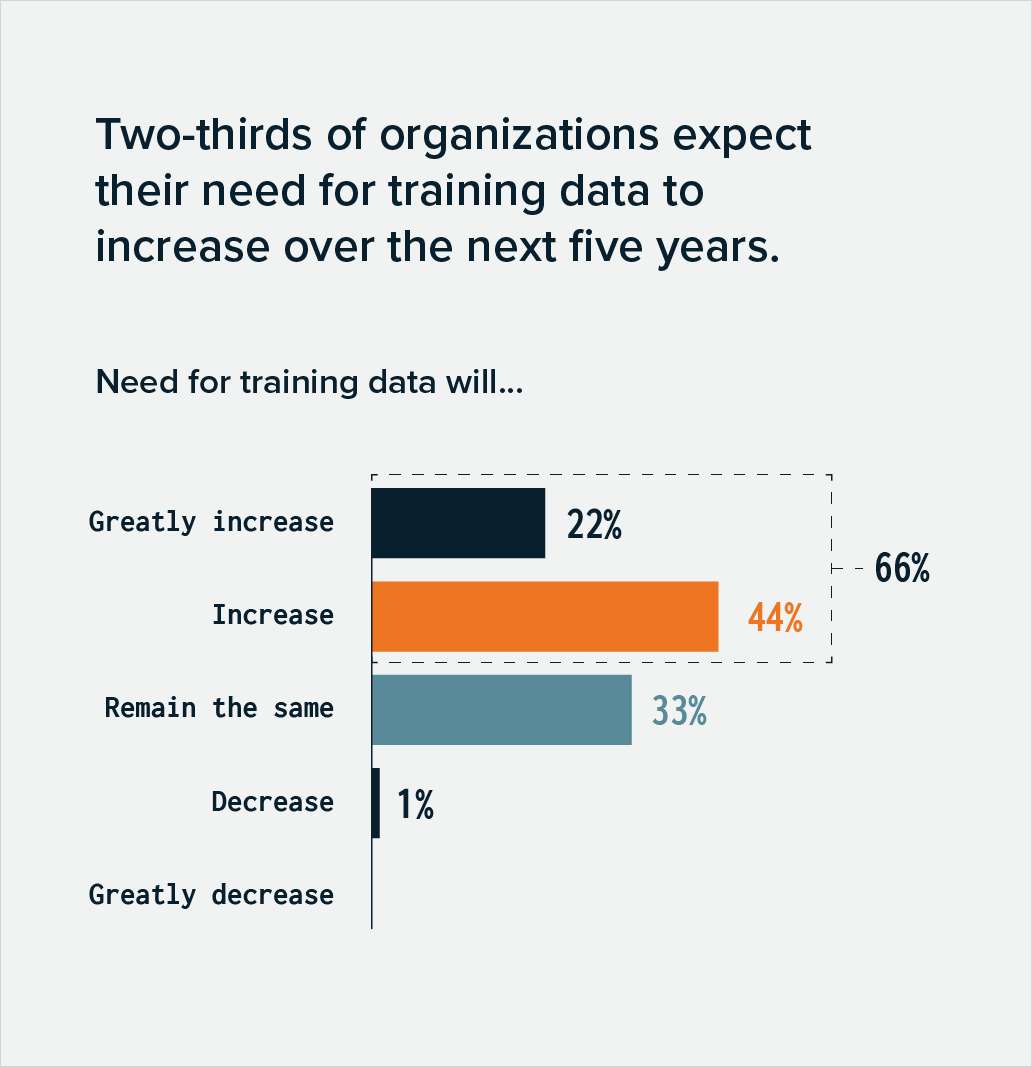
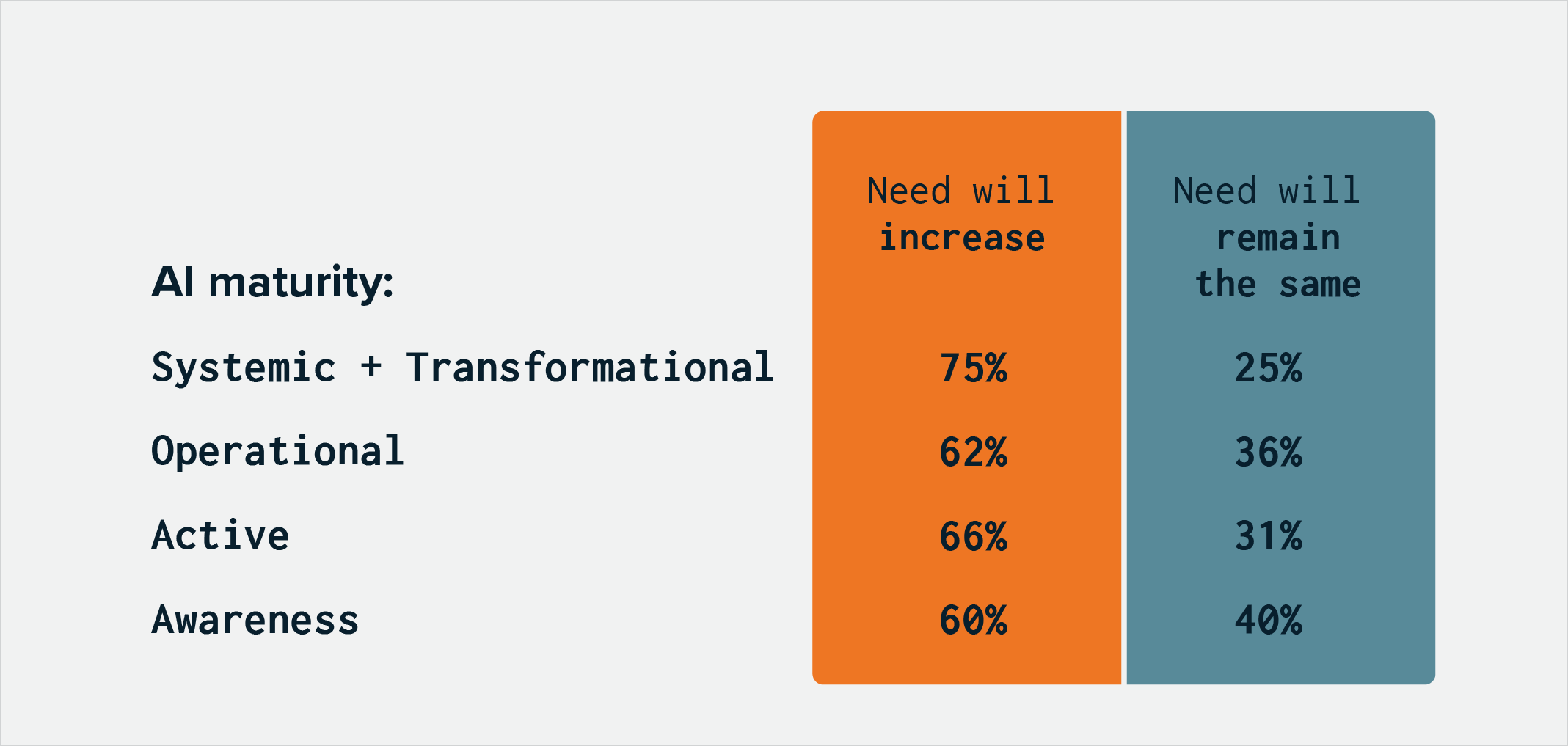
03 AI trends by industry
Financial services companies report highest levels of AI maturity
The financial services industry was an early adopter of AI to maintain competitive advantage in a market that has been disrupted by new entrants. With the growth in customer demand for digital experiences, financial services institutions have embraced AI as a powerful tool to transform their businesses, from internal operations to customer engagement. The availability of structured transactional datasets provides this industry with a strong foundation for AI initiatives; 43% of respondents stated that their organizations have reached the highest levels of maturity.
Following the financial sector is the technology industry; 22% of organizations in this vertical report having reached the Systemic and Transformational levels of AI maturity.
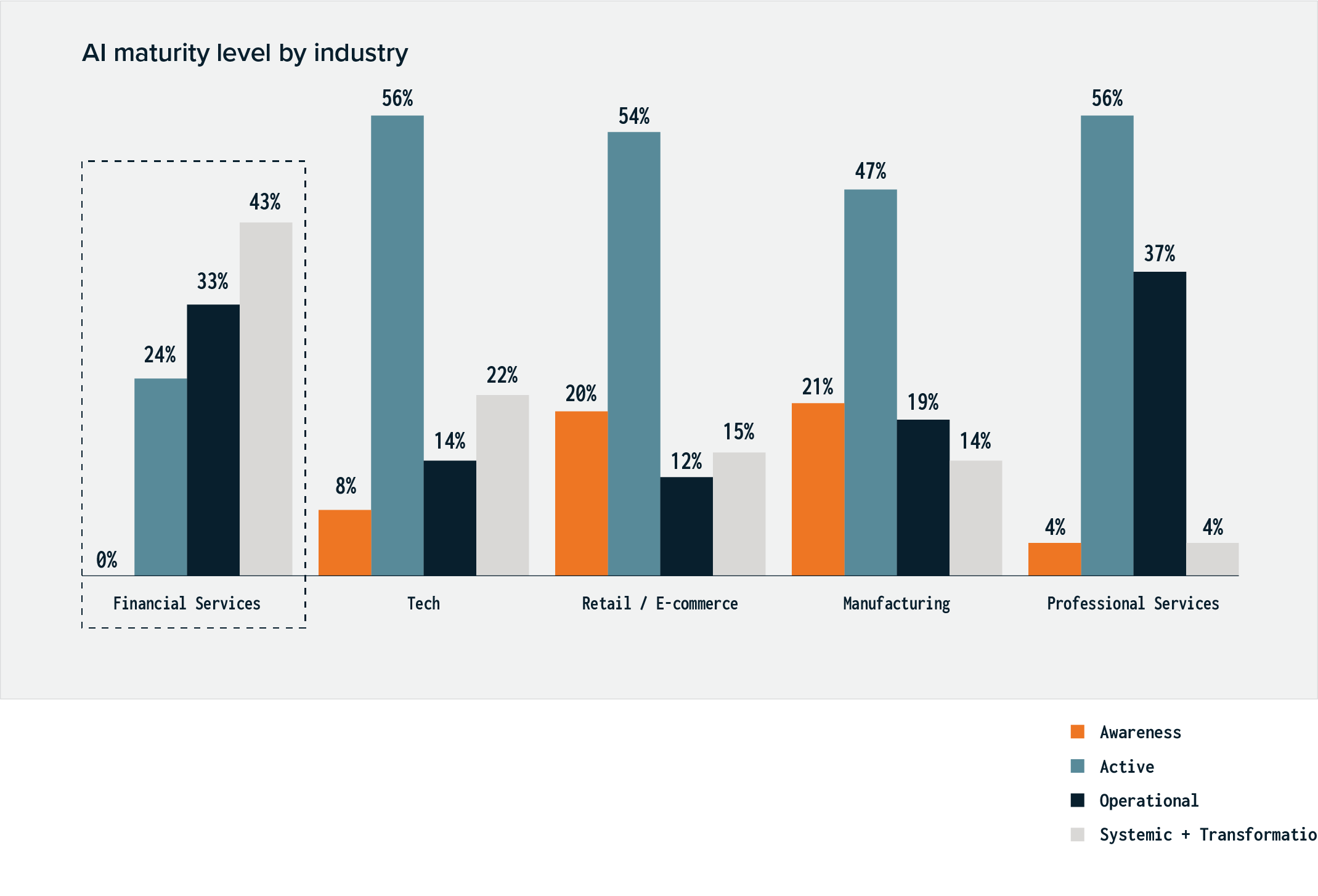
Across industries, efficiency and productivity gains are the main goal of AI strategies
When asked about the benefits that AI can solve in their respective industries, most respondents cited efficiency and productivity gains. In the financial services industry, the ability for AI to improve analytics rose to the top.
Beyond efficiency and productivity, retail and e-commerce companies believe that one of the leading benefits of AI is time to market acceleration, while manufacturing/automotive companies are focused on improving analytics and business model expansion. Tech companies say improved analytics and speed to market are their main problems to solve. Companies in the professional services sector are also looking to improve both their analytics capabilities and competitive differentiation. These nuances show that opportunities for the highest potential impact from AI are viewed differently across industries and demonstrate the wide applicability of the technology.
Survey Q6: In your opinion, what problems can AI solve in your industry, outside of your organization?
Survey Q1: Which of the following best describes the industry you work in?
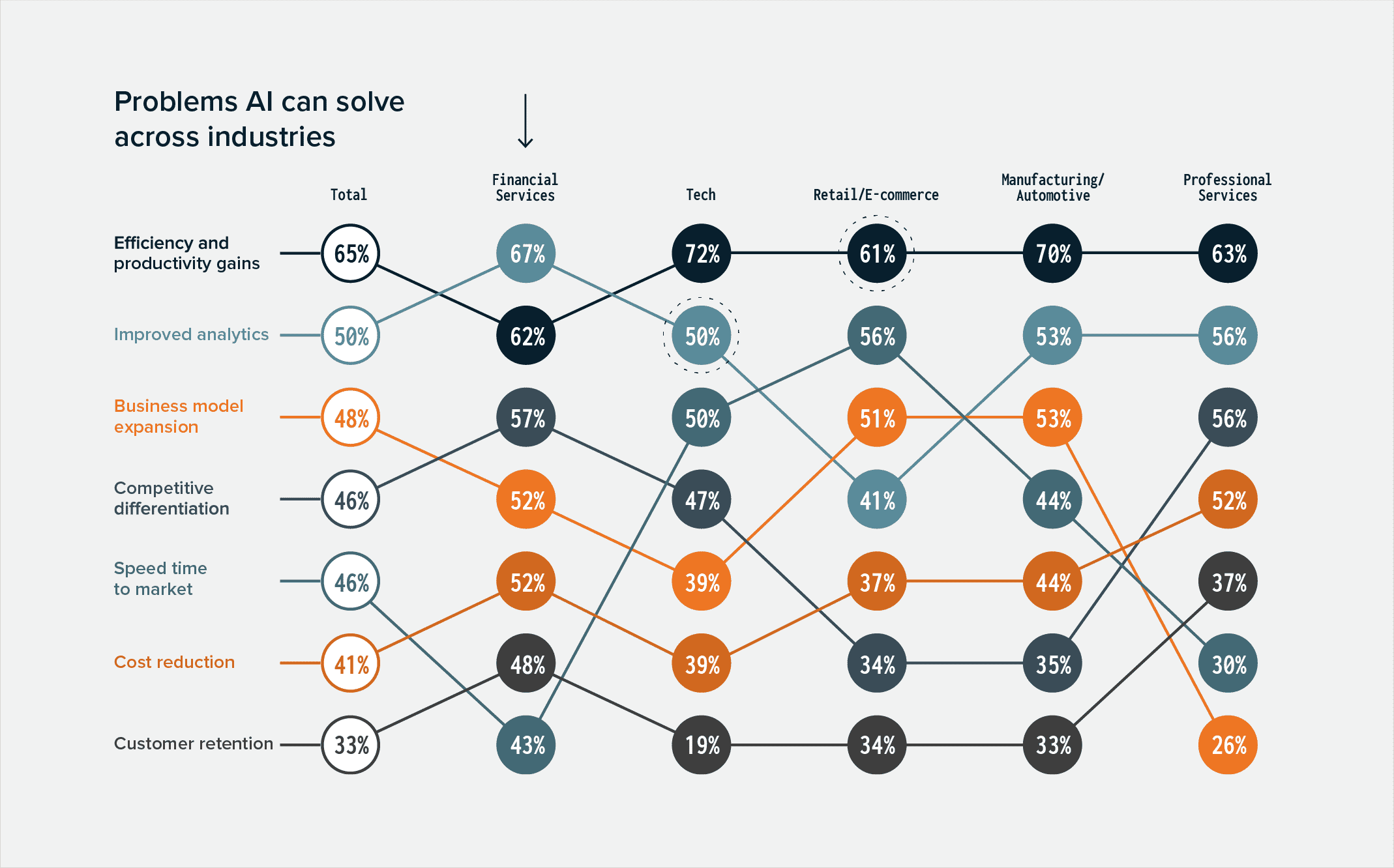
The majority of AI strategies are focused on innovation and product development
For the tech, retail, manufacturing/automotive, and professional services industries, AI is used to innovate and advance product development. These businesses want to provide one-of-a-kind customer experiences that can differentiate them from the competition. For financial services companies however, securing a competitive advantage and risk management are the primary business drivers for AI strategies.
Tech and professional services companies cite risk management as the secondary driver of their AI strategies, while those in the retail industry are also using AI to optimize their supply chains.
Survey Q3: What are the key business drivers of your organization’s AI strategy?
Survey Q1: Which of the following best describes the industry you work in?
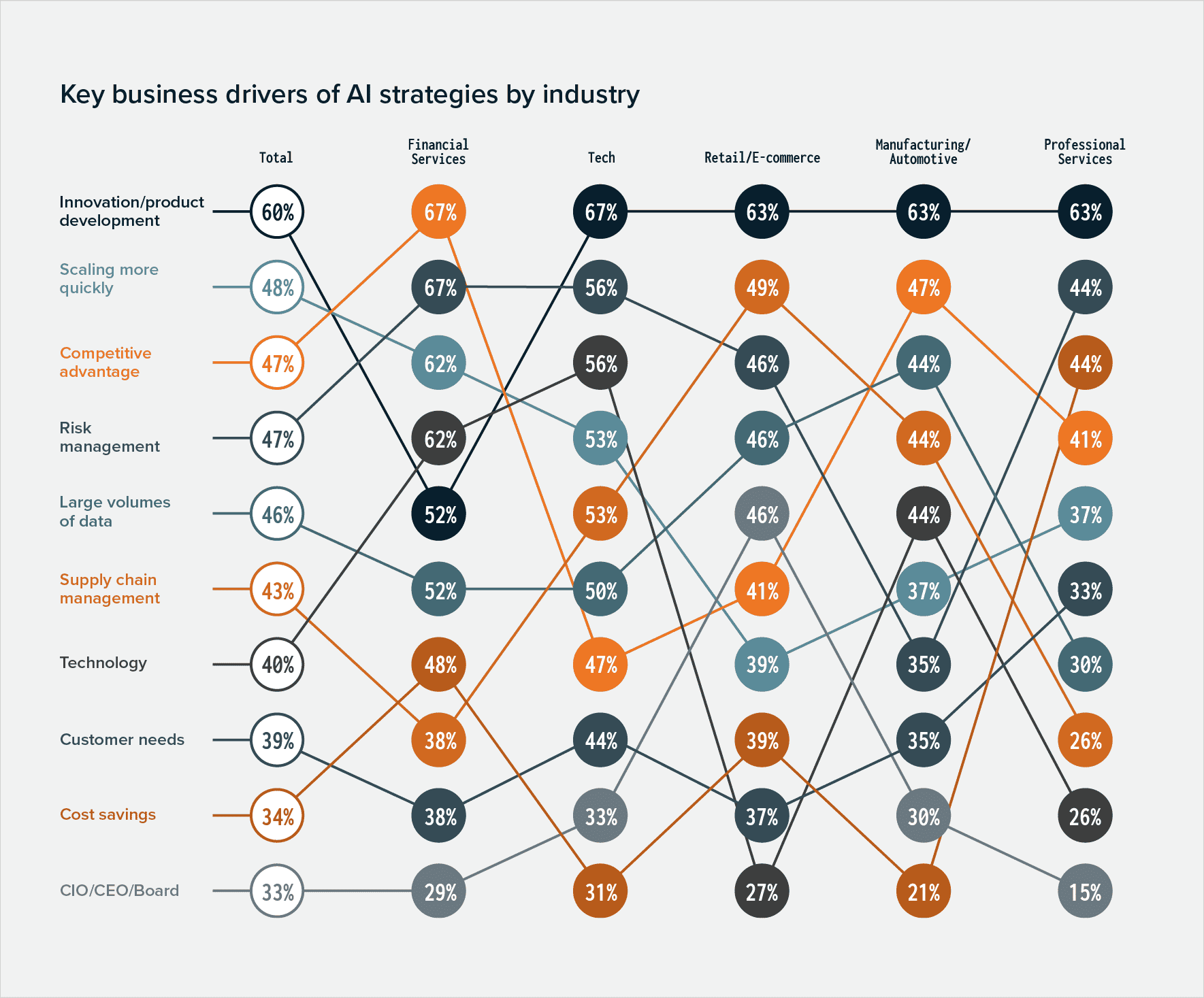
“[AI training data] is a new and important tool and if we don't invest we will be left behind those who do.”
Text is the leading data type used across all industries; future data types include audio, user behavior and video
When asked about the types of data currently used across industries, text data was first on the list, followed by numerical data and then product/SKU data. The financial services industry relies heavily on numerical, text and transactional data as one would expect. In manufacturing/automotive, sensor data is the most used data type. Plans for future data types vary by industry, with audio, user behavior and video data cited the most often.
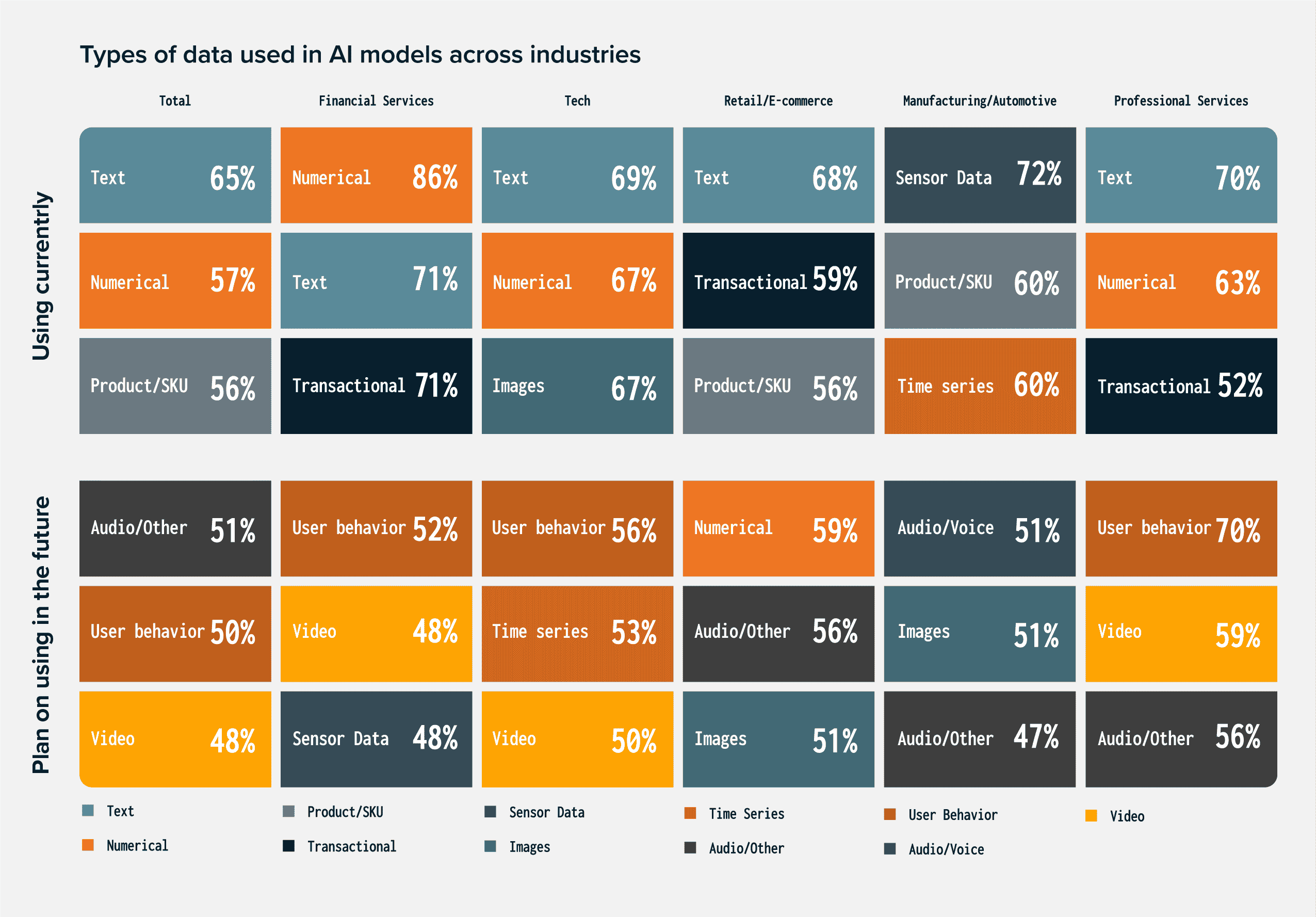
Conclusion
Dedicate higher budgets overall for their AI programs
Companies in the Systemic and Transformational levels on the maturity model are budgeting higher amounts overall for their AI programs. This is empowering, as it illustrates a direct relationship between AI success and allocation of investment. It presents a clear path for businesses looking to get ahead in the AI race
Use AI to scale up and create competitive advantage
The results of the study show that when organizations reach the highest levels of AI maturity, their business drivers shift. While in the earlier phases of AI maturity companies are predominantly focused on deploying AI to drive innovation and product development, a shift occurs at the Systemic and Transformational stages. Organizations that have reached these levels of maturity are now using AI to scale more quickly; they have established a strong foundation with AI and are now well positioned to expand.
Rely on supervised and semi-supervised machine learning
Machine learning models also vary across AI maturity levels. Systemic and Transformational companies are focused on supervised and semi-supervised machine learning approaches while those at the Awareness stage lean more towards unsupervised machine learning.
Consider quality training data to be a key to the success of their AI strategies
Research findings show that as companies move through the phases of AI maturity and reach a tipping point where AI is successfully in production, the value of quality training data increases. Systemic and Transformational organizations say quality training data is the most important contributor to the success of AI strategies, ahead of quality controls and good algorithms. As a result, companies at the highest levels of maturity indicate the strongest need to increase their training data budgets over the next five years.
Path to AI maturity
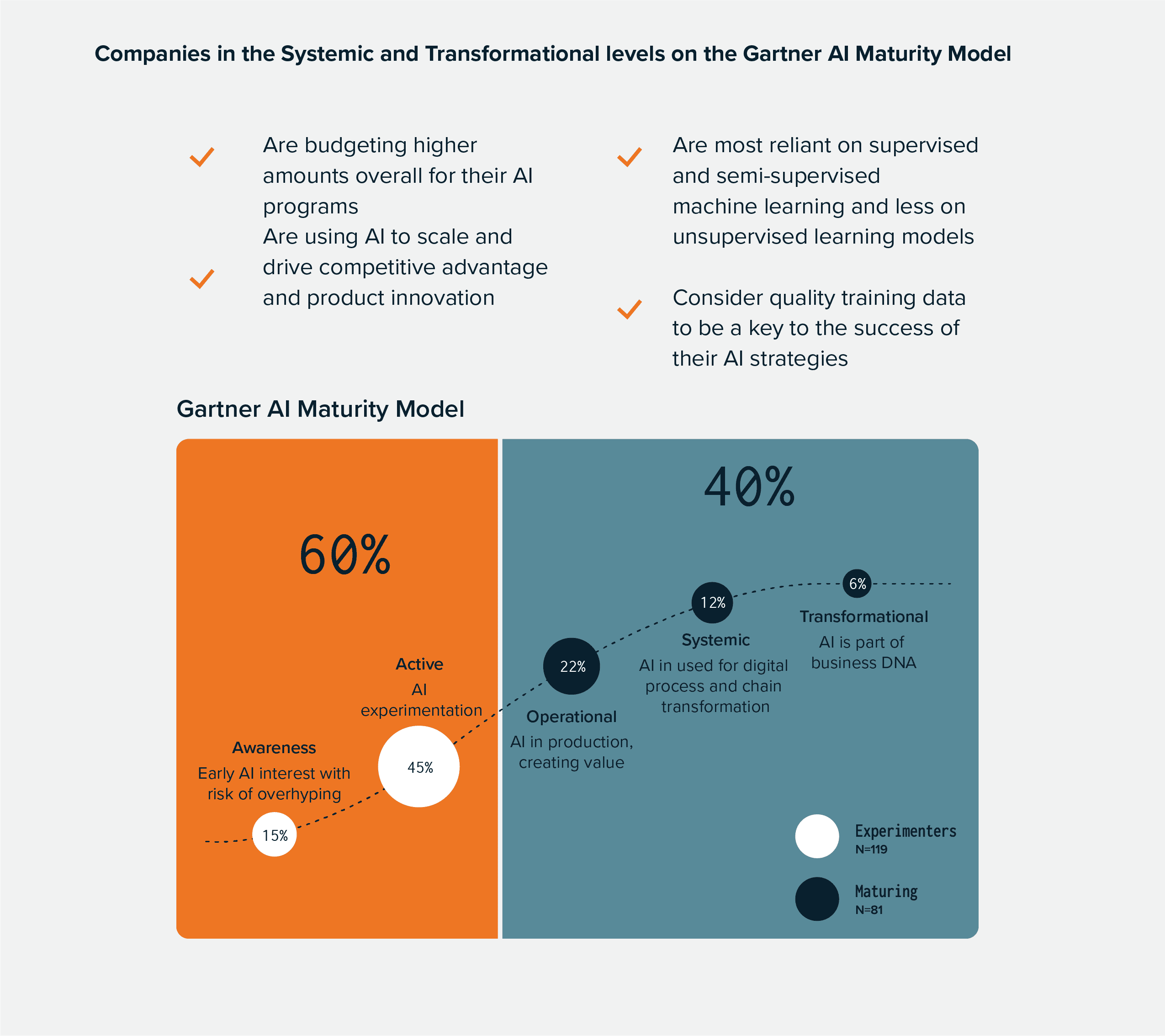
Behind the research
LXT commissioned a survey of 200 senior decision-makers working for US organizations. Two-thirds of our respondents were of C-Suite level and all those who took part had verified AI experience; only 25% of those who applied met the criteria required for participation, which included their level of AI knowledge and experience.
Contributors were engaged using online surveys, answering on behalf of a range of business sizes, revenues and industries. Each participant represents a US organization with at least $100 million in annual revenue and over 500 employees.
The research was conducted from November 29 to December 10, 2021, by Reputation Leaders, an independent research organization. Interviews were conducted in the US by online survey using the panel services of Borderless Access.
Reputation Leaders is a global thought leadership consultancy that causes people to think about your brand positively and differently.
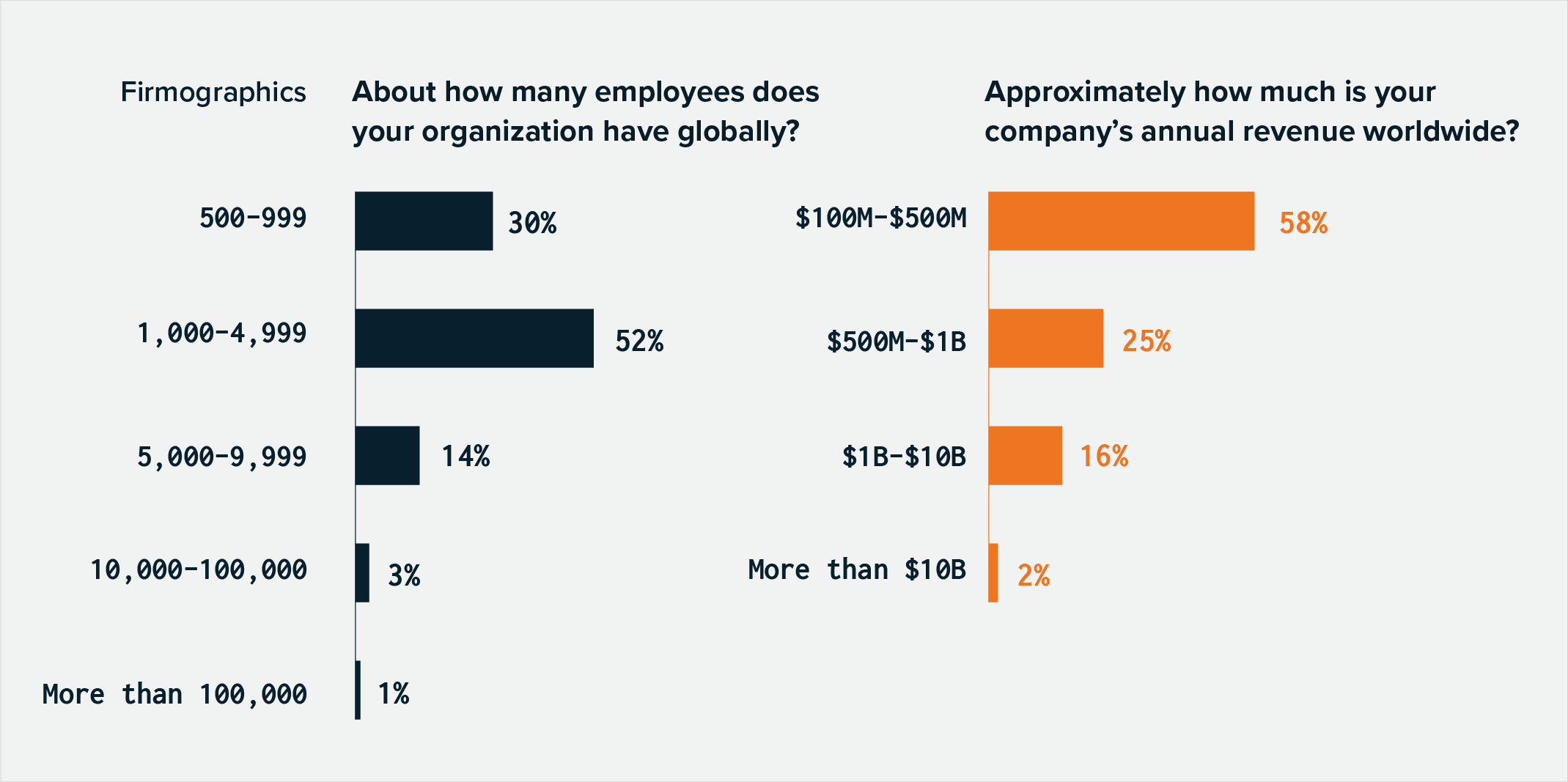
About LXT
Source:
1. https://www.gartner.com/en/newsroom/pressreleases/ 2020-10-19-gartner-identifies-the-topstrategic- technology-trends-for-2021
